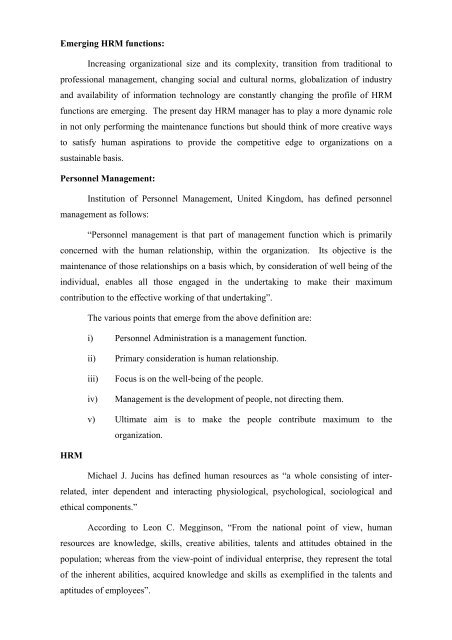UNIT – I Lesson 1 HRM – AN OVERVIEW Lesson Outline Nature of ...
UNIT – I Lesson 1 HRM – AN OVERVIEW Lesson Outline Nature of ...
UNIT – I Lesson 1 HRM – AN OVERVIEW Lesson Outline Nature of ...
You also want an ePaper? Increase the reach of your titles
YUMPU automatically turns print PDFs into web optimized ePapers that Google loves.
Emerging <strong>HRM</strong> functions:<br />
Increasing organizational size and its complexity, transition from traditional to<br />
pr<strong>of</strong>essional management, changing social and cultural norms, globalization <strong>of</strong> industry<br />
and availability <strong>of</strong> information technology are constantly changing the pr<strong>of</strong>ile <strong>of</strong> <strong>HRM</strong><br />
functions are emerging. The present day <strong>HRM</strong> manager has to play a more dynamic role<br />
in not only performing the maintenance functions but should think <strong>of</strong> more creative ways<br />
to satisfy human aspirations to provide the competitive edge to organizations on a<br />
sustainable basis.<br />
Personnel Management:<br />
Institution <strong>of</strong> Personnel Management, United Kingdom, has defined personnel<br />
management as follows:<br />
“Personnel management is that part <strong>of</strong> management function which is primarily<br />
concerned with the human relationship, within the organization. Its objective is the<br />
maintenance <strong>of</strong> those relationships on a basis which, by consideration <strong>of</strong> well being <strong>of</strong> the<br />
individual, enables all those engaged in the undertaking to make their maximum<br />
contribution to the effective working <strong>of</strong> that undertaking”.<br />
<strong>HRM</strong><br />
The various points that emerge from the above definition are:<br />
i) Personnel Administration is a management function.<br />
ii) Primary consideration is human relationship.<br />
iii) Focus is on the well-being <strong>of</strong> the people.<br />
iv) Management is the development <strong>of</strong> people, not directing them.<br />
v) Ultimate aim is to make the people contribute maximum to the<br />
organization.<br />
Michael J. Jucins has defined human resources as “a whole consisting <strong>of</strong> interrelated,<br />
inter dependent and interacting physiological, psychological, sociological and<br />
ethical components.”<br />
According to Leon C. Megginson, “From the national point <strong>of</strong> view, human<br />
resources are knowledge, skills, creative abilities, talents and attitudes obtained in the<br />
population; whereas from the view-point <strong>of</strong> individual enterprise, they represent the total<br />
<strong>of</strong> the inherent abilities, acquired knowledge and skills as exemplified in the talents and<br />
aptitudes <strong>of</strong> employees”.
















